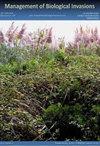开发先进的信息系统以支持压载水管理
IF 1.5
4区 环境科学与生态学
Q3 BIODIVERSITY CONSERVATION
引用次数: 4
摘要
全球压载水管理旨在通过压载水交换和压载水处理等做法减少非本地物种的运输和引入。确保船舶符合压载水管理要求的全面执法是成功的关键部分,但此类活动受到可用资源的限制。有针对性和(或)分层执法活动是充分利用现有资源的一种选择。国际船舶被要求在到达世界各地的许多港口之前提交压载水报告表格,申报数量、地理来源、已进行的管理和预计排放地点。这些数据对于风险评估和趋势分析至关重要,但对于日常运营来说,数据的流入可能是压倒性的,特别是对于拥有许多港口和/或高船舶流量的司法管辖区。近实时访问压载水数据增加了数据验证和验证的机会,并促进了自定义报告,如交换坐标映射和压载水排放统计。定制软件通过集成决策支持工具,实现最佳可用科学的无缝应用。压载水信息系统(BWIS)的开发是为了支持加拿大的日常压载水执法活动和科学研究。BWIS增加了压载水报告数据的可访问性,并简化了数据处理,通过在线平台支持决策。本文章由计算机程序翻译,如有差异,请以英文原文为准。
Developing an advanced information system to support ballast water management
Global ballast water management aims to reduce the transport and introduction of non-indigenous species through practices such as ballast water exchange and ballast water treatment. Comprehensive enforcement to ensure vessels are meeting ballast water management requirements are a key part of success, but such activities are limited by available resources. Targeted and/or stratified enforcement activities are one option to make best use of available resources. International vessels are required to submit ballast water reporting forms prior to arrival at many ports around the world, declaring quantities, geographic sources, management undertaken and expected discharge location. These data are essential for risk assessment and trends analysis, but the inflow of data can be overwhelming for daily operations, particularly for jurisdictions with many ports and/or high vessel traffic. Having near real-time access to ballast water data enhances opportunities for data validation and verification and facilitates customized reports such as mapping of exchange coordinates and ballast water discharge statistics. Customized software enables seamless application of best-available science through integration of decision-support tools. The Ballast Water Information System (BWIS) was developed to support daily ballast water enforcement activities and scientific research in Canada. The BWIS increases accessibility of ballast water report data and streamlines data processing to support decision-making using an on-line platform.
求助全文
通过发布文献求助,成功后即可免费获取论文全文。
去求助
来源期刊

Management of Biological Invasions
Agricultural and Biological Sciences-Ecology, Evolution, Behavior and Systematics
CiteScore
3.40
自引率
6.70%
发文量
21
审稿时长
16 weeks
期刊介绍:
Management of Biological Invasions, established in 2010 by Dr. Elias Dana, is an open access, peer-reviewed international journal focusing on applied research in biological invasions in aquatic and terrestrial ecosystems from around the world. This journal is devoted to bridging the gap between scientific research and the use of science in decision-making, regulation and management in the area of invasive species introduction and biodiversity conservation.
Managing biological invasions is a crisis science, with Management of Biological Invasions aiming to provide insights to the issues, to document new forms of detection, measurements and analysis, and to document tangible solutions to this problem.
In addition to original research on applied issues, Management of Biological Invasions publishes technical reports on new management technologies of invasive species and also the proceedings of relevant international meetings. As a platform to encourage informed discussion on matters of national and international importance, we publish viewpoint papers that highlight emerging issues, showcase initiatives, and present opinions of leading researchers.
 求助内容:
求助内容: 应助结果提醒方式:
应助结果提醒方式:


